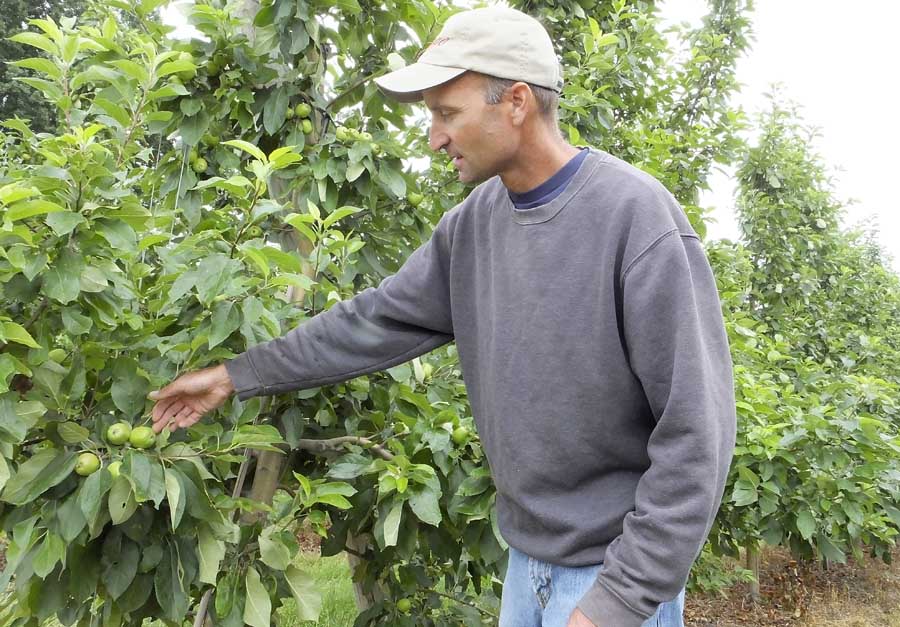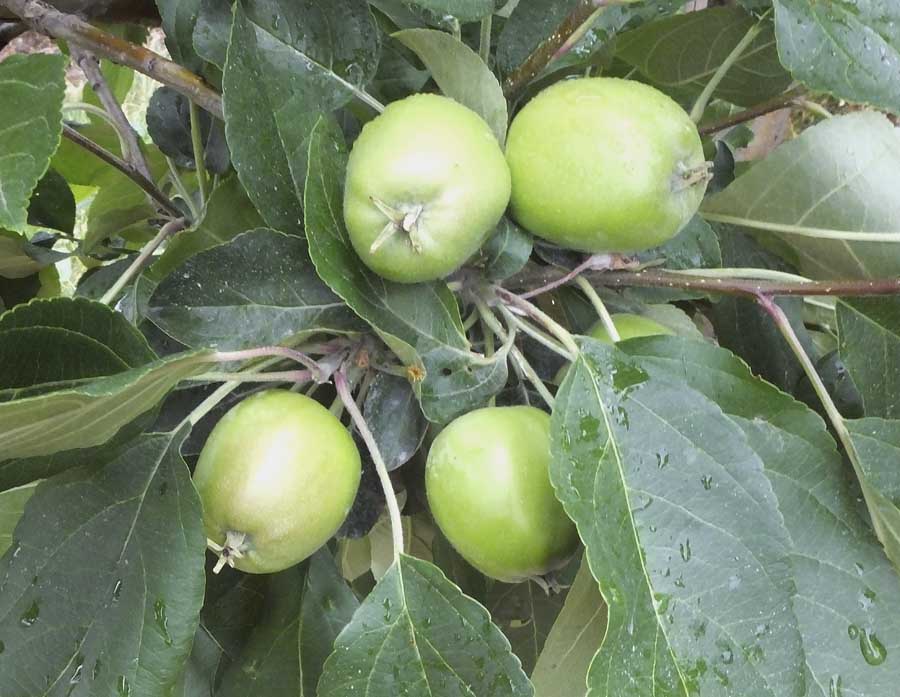
Ripe SweeTango apples in the orchard of a grower in the Next Big Thing cooperative. (Courtesy Next Big Thing)
Released as a managed or “club” apple to retailers in 2009, the Minneiska, sold under the trade name SweeTango, continues to pick up steam.
Harvest numbers dipped in 2015 due to spring frost losses, but it is doing well this year, with a projected 18 percent increase in crop yield from 2015 to 2016, and a 9 percent increase from 2014 to 2016, according to the Next Big Thing Growers’ Cooperative that oversees this variety.
A million Minneiska trees are in the ground today with production of 450,000 packed boxes anticipated in 2016. The cooperative is planning and planting additional trees through 2019 toward production of a million packed boxes.
“If the co-op membership says, ‘Let’s increase the production,’ that’s an optimistic sign,” said Dennis Courtier, who founded Next Big Thing. He grows Minneiska on about 30 acres of his Pepin Heights Orchards in Lake City, Minnesota.
Although new growers have approached Next Big Thing to add the SweeTango Brand Minneiska Apple to their orchards, Courtier said the extra production was “snapped up within the original 47 growers and stakeholders already in the co-op, because our growers seem to have an appetite to produce more.” He added, “I don’t see a time coming certainly in the near future or the intermediate-term future where we really are going to add any substantial number of outside growers.”
Next Big Thing president Theron Kibbe agreed. “We’ve had a lot of calls through the years of growers around the country wanting to participate, but we’ve been able to satisfy retailer demand within the original group of risk-takers, or members, who joined back in 2006.”
In the orchard

A fourth-generation grower, Mike Wittenbach planted his first Minneiska trees in 2009. He said he’s still learning, but he is pleased with the decision to try a managed apple on his south west Lower Michigan farm. (Photo by Leslie Mertz)
Mike Wittenbach, a fourth-generation family farmer in west central Lower Michigan, is one of those who grows Minneiska. It was the first managed variety he had ever grown.
“Planting these Minneiska was a gamble, like anything else we do,” he said, while standing in a block of 6- to 7-year-old trees. In all, Wittenbach Orchards grows Minneiska and 12 other varieties of apples on 200 acres.
Wittenbach said he chose Minneiska because he’s always trying to get a better piece of fruit in consumers’ hands.
Another attraction was that Minneiska is managed, enabling growers to police whether a good piece of fruit ends up on the store shelf. He also liked the idea that the cooperative was going to market the fruit.
“Sometimes farmers think that if we just plant it, somebody will buy it and want it, but what NBT did was to make a conscious effort and take some upfront money to market it and create demand instead of just throwing something out there,” he said.
All of those were important in the development of the Minneiska, according to one of its inventors, David Bedford. Bedford is an apple breeder and senior research fellow at the University of Minnesota Horticultural Research Center.
“It was a cross that we made in 1988 — one of many made that year — to combine the texture of Honeycrisp with the early ripening and complex flavor of Zestar!, which is a little on the tart side but with enough sugar so that it’s beautifully balanced. And for us, SweeTango really hit the mark,” he said.
Lessons from Honeycrisp

SweeTango apples in late June at Wittenbach Orchards. (By Leslie Mertz)
The decision to release it as a managed apple came after University of Minnesota researchers began noticing some unfortunate practices concerning their previous release: Honeycrisp.
“We released it under the open-release model, whereby we license nurseries to produce it, and they sell it to whoever wants to buy it. And that was great. It was easy,” Bedford said.
By the time the Honeycrisp patent expired in 2008, about 10 million Honeycrisp trees had been sold. It had become exceedingly popular and commanded a high price, and that’s when things soured a bit, he said.
“Everybody wanted to grow it, and that’s good to a point, except that not every area is well suited to growing the variety, and in the case of Honeycrisp, it’s a finicky apple that needs the kind of special attention that not everyone was willing to give.”
That, in turn, has sent some less-than-high-quality apples to market.
“We spent 30 years developing that variety and it is a success by all measures with the consumer, and yet now we have to stand on the sideline and watch it go into a free-for-all,” he said. “I’d like to think that at some point the market will sort out the sub-par fruit, but unfortunately right now there is a pretty big range in the quality of fruit being sold as Honeycrisp.”
The lesson from the Honeycrisp experience was that a really good, new apple deserved management, and the SweeTango was one such apple, he said. Again, they used Honeycrisp as an example, but this time they looked at its release in foreign markets as a managed variety. There, Honeycrisp is a consistent, high-quality apple throughout those entire markets, Bedford said. “Clearly, management can work.”
NBT’s role
In 2009, Minneiska became the first managed apple released by a public university. It has worked so far, said Courtier.
“SweeTango offers an opportunity to ensure that the eating quality presented to consumers is as consistent as we can possibly get it. Without some way to manage how they’re grown and how they should be packed, I don’t know how you would get there otherwise.”
To manage SweeTango, the cooperative has several roles. One is to license it to growers who are willing to give the apple the care it needs.
To that end, the cooperative has a best-practices committee to offer advice on the best methods for growing and handling the variety.
Its marketing committee also sets the wholesale price, which is a balancing act to make the apple worthwhile for growers and for retail operations.
“The idea is to maintain a higher grower price over time, to create some market demand, and to get the supply out there, but not to oversupply where we would have to concede some grower dollars on the f.o.b.,” Kibbe said.
In addition, NBT handles the marketing of the SweeTango, which relies heavily on customer trials.
“We had to have consumers try it, be satisfied with it, and make sure they remembered it, because you have to get two or three sales before the notion of the brand is really planted in people’s heads,” Courtier said.
The marketing committee encourages growers to pass out samples at farm stands, invests in grocery store demos, and follows up with a variety of social media projects to reinforce the name SweeTango.
He noted, “SweeTango is still a long way from being a mature brand, but it certainly is established now, and it really does very, very well during its market window against all comers.”
A good choice
For his part, Courtier said he is happy to be a part of the SweeTango story.
“It’s really rewarding, because at the end of the day, an apple is a snack food. Our real competitors are Doritos and Snickers bars, so if apples are going to succeed against other snack foods, they have to be new, memorable and deliver on the promise. And the SweeTango is an apple to do that.”
On the grower side, Wittenbach said he is pleased with his decision to add Minneiska to his Michigan orchard, but like any new fruit, it has taken a while to work out the kinks.
“The tree is grower-friendly, but we are still learning harvest: What are the protocols for when the fruit is at optimum maturity, and what are the protocols for handling it because it is a delicate piece of fruit,” he said.
They had some struggles with russeting early on, but now that the trees have matured, that seems to have settled down.
“So, yes, we’re still learning, but we feel more comfortable with them,” he said. “We’re getting there.”
He has also been very satisfied with the cooperative and the decision to manage the variety.
“I’m a grower, that’s what I feel I do best. I don’t know marketing and I don’t want to know marketing, so this allowed me to access a group that has a wonderful marketing horsepower,” he said.“That’s important because this industry is about more than just growing. It’s about handling and marketing and everything else that gets our apples to the consumer’s mouth.” •
– by Leslie Mertz






I see one major problem here. It is currently illegal for dentists to fix prices on their dental procedures. It is felt that this price fixing would be anti-consumer. Why is growing an apple, say, any different when the numero uno strategy of the club is to keep prices “high”?